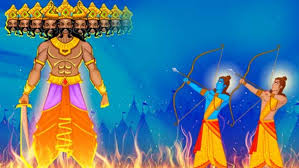Dussehra
Dussehra festival is celebrate in ashwin month according to hindu calendar or in october month in all india.

Dussehra is one of the major Hindu festivals of India. It is celebrated throughout the country with great zeal and enthusiasm. People all over the country participate in the occasion in their own way. It is the day when Lord Rama killed the ten headed demon king Ravana and gave the throne of his kingdom Lanka to his brother Vibhishana. Since that day, the day of Vijaya Dashmi is considered to be auspicious and festive by the people of India and is celebrated as the day that symbolizes the victory of ?Good over Evil?. People throughout the country celebrate the occasion in their own way. The Dusshera of Mysore is very famous in terms of grandeur and splendor. Each region of the country has its own specialty in the celebrations. While at some places people engage in public processions, at some places people participate in Ram Lila and some people organize Ravan Dahan in the city. Feasting and busting crackers are also an important feature of the Dusshera celebrations. At many places in the country, colorful fairs and exhibitions are also organized on this occasion.
Ramlila is the backbone of the celebration of Dusshera in northern India, where the scenes from Rama’s life are depicted, especially Bharat Milap, the reunion of Rama with his brother Bharat, the destruction of Ravana (the highlight of Dussehra) and the return of Rama, Lakshmana and Sita to Ayodhya, their kingdom after fourteen years of exile. In Himachal Pradesh’s Kulu valley, the very ceremonial festivities and grand processions of the village deities of the hill people marks Dussehra. In Delhi and nearby states, oversized effigies of Ravana, Meghnath and Kumbhkaran are burnt in Ramlila, a mela that is organized by different committees, at huge grounds. It is a week long affair in the hill town of Kullu, in Himachal Pradesh. Deities are brought in process to ‘maidan’ in Kullu, to pay respect to the reigning deity of the place – Raghunathji. The huge procession consists of more than hundred deities that are mounted on the colorful palanquins. Ramlila is the next major attraction of Kullu Dusshera.
In Tamil Nadu, the nine days preceding Dussehra have been equally divided for worshipping the three Goddesses namely Lakshmi (the first three days are dedicated to the Goddess of wealth and prosperity), Saraswati (the next three days are dedicated to the Goddess of learning and arts) and Durga (the last three days are dedicated to Mother Goddess, Shakti). The women and children of Tamil Nadu, Andhra Pradesh and Karnataka arrange small statues and dolls, known as ‘Bommai Kolu’, on artificial steps and decorate the steps and the nearby place with beautiful lamps and flowers. From the very first day of the festival, songs and stories form a part of the celebration and a dish made out of chickpeas known as ‘choondal’ is made for the dolls as prasad to relish on. Vijayadashmi is the day when the Bommai Kolu is taken down ceremoniously. On the day of Vijayadashami, vidya aarambh (vidyaarambam) is observed. The day is considered very auspicious, especially for the children to begin their education in academics as well as art. Saraswati puja is done on Vijayadashami. A similar tradition can be seen in Kerala as well. Mysore is famous for a gala procession of richly bedecked elephants on the brightly lit streets of the city on Dussehra. In Mysore, effigies of Ravana, Meghnath and Kumbhkaran are burnt. The Mysore palace is illuminated for a whole month during the festive season of Dussehra. Caparisoned elephants lead a colorful procession through the vibrantly decorated streets of the princely city. In Andhra Pradesh, Dussehra is popularly referred to as Dasara.
In the eastern state of West Bengal, Vijayadashmi is celebrated as the victory of Goddess Durga over Mahishasura, the demon who ruled the swarglok and the earth with his invincible power. It is the last day of the ten-day festival – Durga Puja. On Vijayadashmi, the idol of Ma Durga is immersed in the nearby river or lake ceremoniously, by the devotees. This is called visarjan (submersion of diety). The idol is preceded by a huge procession of devotees. In Orissa, the festival is called Vijoya Dashami. The day is considered the last day of the Sharodiya Durga Puja. After offering the last ritual (Aparajita Puja) to the Goddess, a tearful farewell is bid to her. The immersion of diety is known as ‘Bisarjan Jatra’. After immersing the idol, people in Orissa celebrate ‘Ravan Podi’, wherein the effigies of demon Ravana are burnt.
In Maharashtra, Dussehra is celebrated on the tenth day of the Ashwin month, as per the Shaka Hindu Calendar. On the last day of Navratri, that is Dussehra, the idols installed on the first day of Navratri are immersed in water.
Dussehra marks the victory of Lord Rama over Ravana. People celebrate the occasion with fun and fervor. They visit their friends and relatives and exchange sweets. Aapta tree is worshipped on this day. Exchange of leaves of aapta tree is considered auspicious. The legend of Shami tree, under which the Pandavas of Mahabharata stored their weapons during their 12 years of exile, is associated with the celebrations. As per the legend, the weapons were retrieved by them on this day. Dussehra is considered auspicious to start any new venture, according to the Maharashtrians.
Significance: It celebrates the death of the demon king Ravana at the hands of Lord Rama.
